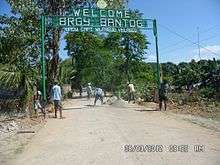Anao, Tarlac
| Anao | ||
|---|---|---|
| Municipality | ||
|
| ||
| ||
 Map of Tarlac showing the location of Anao | ||
.svg.png) Anao Location within the Philippines | ||
| Coordinates: 15°43′44″N 120°37′34″E / 15.72889°N 120.62611°ECoordinates: 15°43′44″N 120°37′34″E / 15.72889°N 120.62611°E | ||
| Country | Philippines | |
| Region | Central Luzon (Region III) | |
| Province | Tarlac | |
| District | 1st District | |
| Founded | 1870 | |
| Barangays | 18 | |
| Government[1] | ||
| • Mayor | Edgardo S. Felipe | |
| Area[2] | ||
| • Total | 23.87 km2 (9.22 sq mi) | |
| Population (2010)[3] | ||
| • Total | 10,873 | |
| • Density | 460/km2 (1,200/sq mi) | |
| Time zone | PST (UTC+8) | |
| ZIP code | 2310 | |
| Dialing code | 45 | |
| Income class | 5th class | |
| Website |
anaotarlac | |
Anao is a 5th class municipality in the province of Tarlac, Philippines. According to the 2010 census, it has a population of 10,873 people.[3]
As the smallest municipality in the province, Anao covers a total land area of 2,387 hectares (5,900 acres).[2] The area occupied by the municipality was formerly a part of Pangasinan. It is 34 kilometres (21 mi) east of the provincial capitol and nestling on the Tarlac-Nueva Ecija border. Located in the north-eastern part of Tarlac, it is bounded on the north by San Manuel, in the east by Nampicuan, on the south by the Ramos and on the west by the Paniqui and Moncada.
Barangays
Anao is politically subdivided into 18 barangays.[2]
- Baguindoc (Baguinloc)
- Bantog
- Campos
- Carmen
- Casili
- Don Ramon
- Hernando
- Poblacion
- Rizal
- San Francisco East
- San Francisco West
- San Jose North
- San Jose South
- San Juan
- San Roque
- Santo Domingo
- Sinense
- Suaverdez
History
The area where Anao is located was inhabited before 1800 by people from the Ilocos Region. In 1835, a group of immigrants from Paoay, Ilocos Norte reached the region and first settled near a creek on the bank where there were balete trees. These immigrants called their settlement "Balete". The immigrants found that the region where they settled has many agricultural prospects and this attracted more immigrants who came from the north, especially from the town of Paoay. The settlement expanded and became a barrio named Balete which later changed to Barrio Anao deriving from the Ilocano word "Danao" which means creek. By that time, balete trees were extinguished and the barrio was adjacent in all directions by creeks. Paniqui then stood as one municipality and had a road extended toward the east to Barrio Anao. Paniqui had more rights to claim Anao as its barrio and the people of the barrio accepted the claim.
Demographics
| Population census of Anao | ||
|---|---|---|
| Year | Pop. | ±% p.a. |
| 1990 | 7,955 | — |
| 1995 | 9,240 | +2.85% |
| 2000 | 10,045 | +1.81% |
| 2007 | 10,806 | +1.01% |
| 2010 | 10,873 | +0.23% |
| Source: National Statistics Office[3][4] | ||
Anao is predominantly an Ilocano-speaking town although most are fluent in Tagalog. Other languages like Kapampangan and Pangasinan are spoken by about 10% of the population.
Aglipayan and Roman Catholicism are two of the predominant religions.
Attractions, points of interest
In the center of the town near the Municipio or Presidencia is the (F-1935) Saint John Nepomucene Parish Church of Anao.[5] Fr. Mike Marquez and Father Ricky Barayoga are its Parish Priest.[6][7] It belongs to the Roman Catholic Diocese of Tarlac[8] at Poblacion St., Anao 2310 Tarlac, Philippines, Titular: St. John Nepomucene, Feast on May 16 under the Vicariate of St. Rose of Lima.[9]
Ylang Ylang festival is celebrated by the municipality to take pride of their local products, The scent of Ylang Ylang.
Images
-
Saint John Nepomucene Parish Church of Anao
-
Ilang-ilang trees line all the streets
-
Covered court
-
Poblacion chapel
-
Town hall Facade
-
Town plaza and park
-
Auditorium
-

Barangay Bantog
References
- ↑ "Municipalities". Quezon City, Philippines: Department of the Interior and Local Government. Archived from the original on 2013-01-25. Retrieved 28 November 2012.
- 1 2 3 "Province: Tarlac". PSGC Interactive. Makati City, Philippines: National Statistical Coordination Board. Archived from the original on 2013-01-25. Retrieved 28 November 2012.
- 1 2 3 "Total Population by Province, City, Municipality and Barangay: as of May 1, 2010" (PDF). 2010 Census of Population and Housing. National Statistics Office. Retrieved 28 November 2012.
- ↑ "Province of Tarlac". Municipality Population Data. LWUA Research Division. Retrieved 11 September 2013.
- ↑ Category:Saint John Nepomucene Parish Church of Anao - Wikimedia Commons
- ↑ https://plus.google.com/100796881347529245823/about?gl=ph&hl=fil
- ↑ Diocese of Tarlac
- ↑ Diocese of Tarlac, Philippines
- ↑ catholic-diocese-of-tarlac/ List of Parishes of the Roman Catholic Diocese of Tarlac | Philippine Churches
External links
| Wikimedia Commons has media related to Anao, Tarlac. |
- Website
- Amor Village
- Anao town
- Town of Ilang-Ilang flowers
- ANAO: SERENE TOWN OF ILANG-ILANG BLOSSOMS
- Philippine Standard Geographic Code
- Philippine Census Information
- Local Governance Performance Management System
- Pasyalan Tarlac
 |
San Manuel |  | ||
| Moncada | |
Nampicuan, Nueva Ecija | ||
| ||||
| | ||||
| Paniqui | Ramos |
